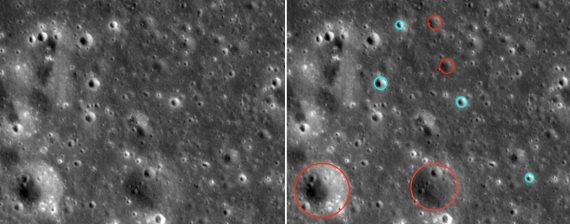Impact craters go through an aging process. They start out new and pristine, but they gradually degrade. This is because impact events are happening all the time, and the craters they create are eventually bashed up by other impact events. The very smallest impacts – the micrometeorite impacts – are constantly wearing down the lunar surface, almost like it is being sandblasted.
Let’s consider “simple” craters. Newly made simple craters are fresh, with sharply defined rims, and deep bowl shaped depressions. The craters gradually degrade until they are “soft” looking, and no longer have deep bowl shapes. Instead they appear more “flattened.” The images below show a portion of the lunar surface covered with simple craters. Some are fresher, while others are more degraded.

Two images of the same portion of the lunar surface showing simple craters in all stages of aging (degradation.) Examples of newer, fresher craters are circled in blue, while examples of older, more degraded craters are circled in red. Credit: NASA/Goddard Space Flight Center/Arizona State University.
After the images above were taken, something exciting happened on the Moon. An impact event occurred and a brand new crater was formed! The image below shows the exact same portion of the lunar surface as above, but now there is a perfectly fresh, new crater right in the center of the image. This is an example of what craters look like right after they form. They have obvious ejecta blankets and long rays stretching out from their rims. Ejecta blankets and rays are relatively short-lived features. They get “sandblasted” away quickly. So if you see these structures, it is a possible indication that the associated crater is young. To verify, check and see if the rim is nicely defined, and if the crater itself is still deep, not flattened.
As we count craters here at CosmoQuest, we are usually interested in all these types, from the youngest to the most degraded. It takes a sharp eye and some practice to catch them all!

The bright, small impact crater in the center of this image of the lunar surface was created on March 17, 2013. This new crater is very small, about 60 feet wide. And yet changes on the surface caused by this impact event were found as far away as 19 miles! Credit: NASA/Goddard Space Flight Center/Arizona State University.




 Join the Crew!
Join the Crew!
 Escape Velocity Space News
Escape Velocity Space News
ok. on moon where a lot of impacts take place this would be a plausible explanation. but on earth? the sudbury crater is thought to be 160 miles across when it struck. now its only 81 miles. why?